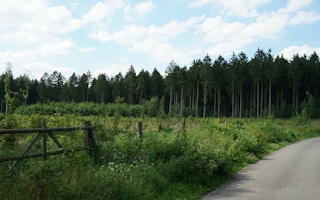Trees are a logical solution to climate change, but allowing or encouraging trees to spread into areas where they don’t typically grow, such as tundra and grasslands, can actually do more harm than good.
A newly published review paper in the journal Frontiers in Ecology and the Environment asks the question: “Should tree invasions be used in treeless ecosystems to mitigate climate change?”
The short answer: not usually.
Invasive trees may capture less carbon than the treeless ecosystem they overrun due to soil disturbance, increased risk of fires, and changes in light absorption.
These results have implications for policies and initiatives. In New Zealand, for example, carbon credits have been used to discourage the removal of invasive, non-native trees. These credits essentially allow businesses to emit greenhouse gases in exchange for the carbon taken up by the invasive trees.
Likewise, the Paris Agreement, Bonn Challenge, and Trillion Trees Initiative all promote tree planting under the logic that trees remove carbon from the atmosphere and lock it in their biomass as they grow.
While this is true, scientists now know that when it comes to carbon accounting, calculating the balance is not so simple.
Globally, more carbon is stored in soil than in all of the Earth’s plants and the atmosphere combined. In some cases, when trees invade, they disrupt the soil, releasing more carbon from below the ground than they can capture and store above it.
A 2020 study found that in the Scottish moorlands, experimental areas planted with trees stored less carbon after several decades than untouched plots covered in native heather.
“It was counterintuitive that in some cases, planting trees can have the opposite effect to what we’ve been taught in school and actually lead to a loss of carbon from the ecosystem rather than sequestering it,” Nina Friggens, lead author of the 2020 study and current postdoctoral fellow at the University of Exeter, told Mongabay in a 2020 interview.
“We’re not trying to say that tree planting doesn’t work,” Friggens said. “[B]ut in terms of trees for carbon, we need to be careful where and what we plant.”
Non-native trees can also make a landscape more susceptible to fire by bringing biomass (and carbon) aboveground, where it can burn more easily.
In Florida, the invasion of broad‐leaved paperbark trees (Melaleuca quinquenervia) into wetlands has made fires more intense. Likewise, in the Patagonian steppe of South America, invasions of pine trees have added more fuel and connectivity to fires, ramping up their severity.
“
It’s important to consider impacts beyond just carbon storage, including the negative impacts of tree invasions on biodiversity and on human communities, through reduction of streamflow and increased fire risk.
Kimberley Davis, research scientist, University of Montana
“This type of [invasive] forest has greater biomass than native forests, i.e., more combustible material and can be highly flammable, thus increasing the frequency and intensity of fires. This problem entails important costs for human welfare, and generates problems for carbon storage,” Anibal Pauchard, a co-author of the 2021 review paper, said in a press release.
And as climate change worsens, forest permanence, the idea that forests will persist for decades or centuries, is threatened by increasing fires.
“Current risks are not carefully considered and accounted for, much less these increased risks that forests are going to face in a warming climate,” William Anderegg, a biologist at the University of Utah, told Mongabay.
Increased forest cover in cold and temperate regions can also cause net warming by altering albedo, the amount of sunlight and radiation reflected from the Earth’s surface. Across the high latitudes in Canada or Russia, for instance, the reflective nature of the snow cools the planet. So having trees in these areas covers the snow, making the land darker and thus warmer.
There are a few ways that trees end up in formerly treeless areas. Trees can be planted there (afforestation); native trees may spread there naturally (woody encroachment); or non-native trees invade, and are often fast-growing (tree invasion). There is evidence that in all three of these cases, trees can do more harm than good for the local carbon budget, and also for the ecosystem as a whole.
“Professionals and decision makers may think that maintaining or even promoting the invasion of these non-native trees and replacing other natural ecosystems may be a way to combat climate change,” said Martín Núñez, lead author of the 2021 review paper and professor at the National University of Comahue, Argentina and the University of Houston. “But unfortunately, that vision is partial and must incorporate all these negative effects.”
The effects of tree invasions on fire, albedo, soil carbon, as well as native species will differ from place to place. In some cases, it makes sense to leave these trees in place, such as when removing them would be prohibitively expensive, do long-term damage to the soil, or when the trees can be managed and kept from spreading.
“When making decisions regarding management of tree invasions, it’s important to consider impacts beyond just carbon storage, including the negative impacts of tree invasions on biodiversity and on human communities, through reduction of streamflow and increased fire risk,” Kimberley Davis, a co-author of the 2021 review from the University of Montana, said in a press release.
Or more simply, Núñez says, “Trees are not always the answer.”
This story was published with permission from Mongabay.com.










